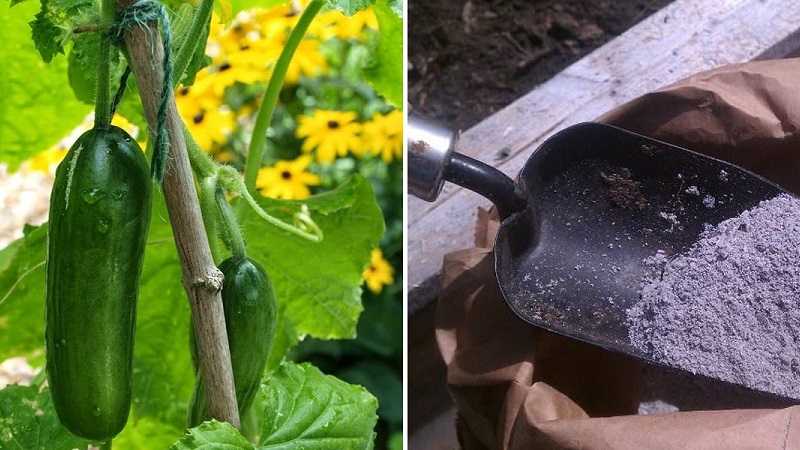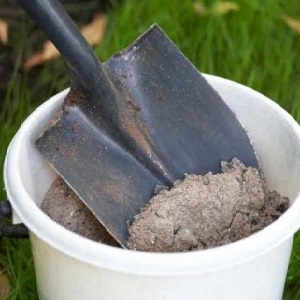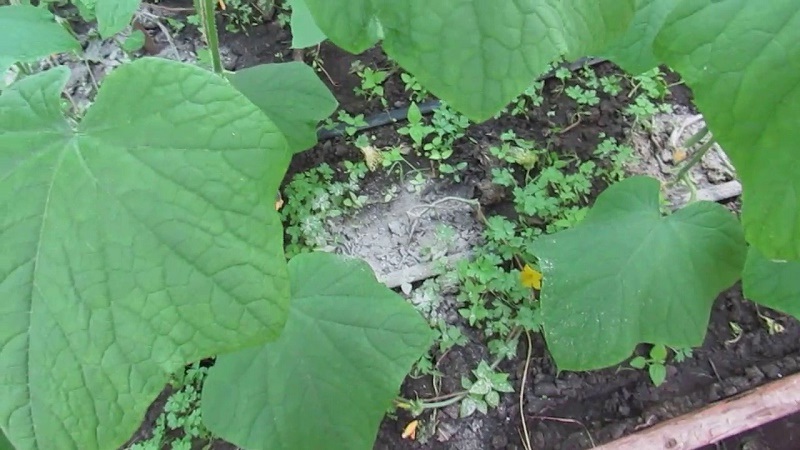How to feed cucumbers with ash in the open field and in a greenhouse, and what this will give to the future harvest
For full growth and development, cucumbers need loose soil, rich in humus and minerals. The garden soil is gradually depleted and depleted during annual cultivation. To prevent this from happening, it is important to regularly fertilize the site.
Of all the known fertilizers for cucumbers, ordinary ash becomes a real find for the summer resident. This affordable product will replace many expensive fertilizers and help increase your crunchy cucumber yield.
The content of the article
Why feed the cucumbers with ash
Ash is a non-combustible combustion residue and a valuable organic fertilizer... It contains practically all the macro- and microelements necessary for plants in an easily assimilable form: phosphorus, potassium, calcium, iron, sulfur, silicon, manganese, magnesium, boron, molybdenum.

Depending on which plants are burned, the composition of the wood slag will change:
- a substance obtained from deciduous trees and grasses (sunflower, buckwheat), contains a high concentration of potassium;
- conifers, rye and wheat straw when burned give ash rich in phosphorus.
Since ash contains the most phosphorus and potassium, it will be an excellent alternative to phosphorus and potassium supplements.
Phosphorus is necessary for cucumbers during the period of active formation green mass and in the phase of tying future cucumbers.
Available potassium will increase the resistance of the crop to pests and diseases, will ensure the rapid growth of a strong root system and vegetative mass, will help the moisture-loving cucumber regulate the water balance.
Attention! Do not feed the cucumbers with ashes formed after burning household waste (newspapers, magazines, boxes) with printing impregnations and dyes. In addition to the remains of pesticides, the plant will receive nothing.
Top dressing with this valuable fertilizer for cucumbers is necessary:
- on acidic soils to neutralize acidity;
- during flowering and the formation of ovaries on cucumbers;
- in the autumn preparation of beds for cucumbers.

Pros and cons of such fertilization
Benefits of using at the summer cottage of ash as a top dressing:
- 100% natural composition;
- lack of chlorine in the composition;
- fast and affordable nutrition of the crop (thanks to the dusty fraction, it quickly dissolves in water and mixes in the soil);
- improving the mechanical composition of the soil;
- alkalinization of acidic soil;
- free raw materials;
- ease of preparation of the main fertilizer and solution.
Plant ash is one of the best environmentally friendly fertilizers for cucumbers and other crops... However, making fertilizer is not as easy as it seems at first glance.
Cons of using:
- carbon monoxide pungent smoke generated when burning plant debris (when a fire is on, stand only on the leeward side);
- harm to plants and humans in case of non-observance of technology (mixing plant and household waste into one fire);
- excessive fertilization (more than 6-7 times per season) - with excessive application, the soil is oversaturated with salts, its porosity and air permeability are disturbed, the soil becomes unsuitable for growing cucumbers.
It can be useful:
Feeding tomatoes and cucumbers with whey
What kind of soil do cucumbers like and how to properly process it
When and how to feed cucumbers in the open field with ash
Throughout the season, 4-6 dressings are enough for a cucumber:
- the phase of plant development, when 1-2 true leaves appear;
- at the stage of dissolution of the first flowers;
- at the beginning of fruiting;
- the next 2-3 dressings are applied throughout the entire fruiting period with an interval of 1 time in 14 days.

Dry application
Dry ash is used to domesticate a future place for planting cucumbers... When digging the beds before sowing, add 100 g (1 glass) of the substance to 1 m². In heavy soil, ash is brought in for digging in autumn and spring, and in light sandy loam - only in spring (due to the rapid leaching of nutrients).
When sowing seeds (or planting seedlings) along the planned plantings of cucumbers, a groove is made 10-15 cm deep, where dry ash is poured and immediately covered with earth.
Important! Never mix ash with mineral fertilizers (superphosphate, carbamide, etc.). When they are mixed, alkaline compounds are formed, nitrogen is lost, and phosphorus passes into a form that is difficult to access.
How to prepare a solution
Liquid ash top dressing is needed for cucumbers during their active flowering and fruiting... To prepare the solution, take 100-150 sifted ash and dissolve in a bucket of water. Watering rate: 0.5 l of solution per adult plant.
Attention! Use warm water for watering ash. After watering with cold water, cucumbers can get sick with fungal diseases due to hypothermia of the roots.

How to prepare fertilizer for future use
It happens that too much ash is obtained (for example, when burning branches left after the autumn pruning of an orchard). For the remaining season it is not used, and it is irrational to throw away good raw materials. For preparation for future use, you will need a dry room (utility block, barn, greenhouse dressing room) and storage containers (boxes, thick plastic bags).
Ash is afraid only of dampness... From time to time, it does not lose its valuable properties and, if properly stored, will last more than one season.
How to apply top dressing correctly
1 glass of ash powder is dissolved in a bucket of water and allowed to brew for 5-7 days... This amount of solution is enough for 2 m2 area (0.5 liters of liquid fertilizing is consumed per plant). The frequency of feeding is 1 time per 14 days.
In liquid form
Ash is used as a remedy for pest control, disease control and as foliar feeding. For foliar top dressing, it is recommended to combine ash with urea. These two fertilizers can be mixed, one component will complement the other. The dosage of substances when preparing a spray solution in different months will differ:
- in the first half of the season (May - early July) - 12 g of urea and 250 g of wood ash are bred in a bucket of water;
- from mid-July to the end of fruiting - 5 g of urea and 250 g of ash.

If you decide to grow cucumbers completely without "chemistry", use the folk recipe:
Pour boiling water over 300 g of sifted ash and leave for 25-30 minutes. The resulting infusion is brought to a working solution of 10 liters of water.
Reference! In order not to burn the plants, observe the dosage for the preparation of the solution, spray only in cloudy weather.
Features of the use of top dressing from ash for cucumbers in a greenhouse
In a greenhouse, the soil should be completely changed every 3-5 years.... The introduction of ash dressings for cucumbers in a greenhouse does not differ from fertilizing cucumbers in open ground. The only feature is that cucumbers go through all development phases faster in the greenhouse, so the frequency of watering at the root can be reduced up to 3-4 times.
When foliar spraying of plants, it is useful to process the walls of the greenhouse.... Protected ground is a breeding ground for fungi, but they are afraid of ash. Irrigation in greenhouses is carried out in the morning so that cucumber leaves remain dry at night.
Read also:
Tips from experienced summer residents
To feed the cucumbers with ashes to their advantage, follow the recommendations on the preparation of fertilizer and advice from summer residents who successfully use ash solutions on their site:
 Use ashes to soak cucumber seeds. Soaking the seeds for 4-5 hours will give future plants protection from pests and diseases and additional nutrition. To prepare the ash infusion, mix 20 g of ash and 1 glass of water. You can use the infusion 24 hours after preparation.
Use ashes to soak cucumber seeds. Soaking the seeds for 4-5 hours will give future plants protection from pests and diseases and additional nutrition. To prepare the ash infusion, mix 20 g of ash and 1 glass of water. You can use the infusion 24 hours after preparation.- For cucumbers, it is important to frequently apply ash in minimal doses. The peculiarity of this culture is the gradual absorption of feeding a little bit.
- Reduce mineral supplements during the pouring period. Ash is often recommended to be mixed with nitrogen and potash fertilizers, but cucumber is a watery vegetable. Everything that the plant absorbs at the time of fruit growth will be in the cucumber harvest.
- It is necessary to add dry ash before watering, so that all its useful elements immediately go to the roots.
Reviews
Gardeners actively use ash as fertilizer and respond positively to the results of fertilizing... The main thing is to first find out whether it is possible to fertilize the ash beds on your site and find out what is the composition of the soil there.
Nadezhda, Moscow region: “Ash is just a universal thing. I am now retired and I cannot afford many fertilizers. And it replaces a whole set of tools for me at once: as fertilizer, as a means of protection against pests and diseases, as a soil deoxidizer ".

Alexander, Lipetsk region: “It’s just the property of ash to deoxidize the soil is not useful for everyone. At my dacha, the soil is alkaline, cucumbers grow beautifully. If you add it, you can upset the acid balance ".
Maya, Tver: “I always, like cucumbers will sprout and form 3 leaves, I make watering holes around the plants. I water the cucumbers in them, and when they bloom, I add an ash talker every 10 days. I don’t complain about the harvest ”.
Conclusion
The experience of many gardeners has shown in practice that the use of ash as fertilizer in the cultivation of cucumbers helps to increase yields, and on acidic soils, its introduction is simply necessary. It is important to apply fertilizers in the recommended amount and monitor the reaction of plants to feeding.